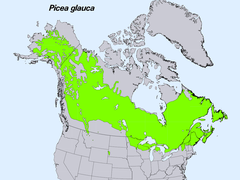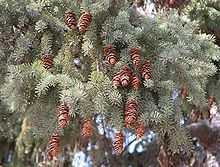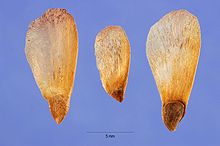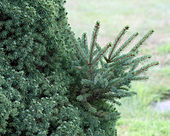- Picea glauca
-
Picea glauca 
Mature white spruce in Alaska Conservation status Scientific classification Kingdom: Plantae Division: Pinophyta Class: Pinopsida Order: Pinales Family: Pinaceae Genus: Picea Species: P. glauca Binomial name Picea glauca
(Moench) VossPicea glauca (white spruce) is a species of spruce native to boreal forests in the north of North America, from central Alaska east to Newfoundland, and south to northern Montana, Minnesota, Wisconsin, Michigan, upstate New York, Vermont, New Hampshire, and Maine; there is also an isolated population in the Black Hills of South Dakota and Wyoming.[1][2][3][4][5] It is also known as Canadian spruce, skunk spruce, cat spruce, Black Hills spruce, western white spruce, Alberta white spruce, and Porsild spruce.[6]
Contents
Description
The white spruce is a large evergreen tree which grows normally to 15 to 30 metres (49 to 98 ft) tall, but can grow up to 40 metres (130 ft) tall with a trunk diameter of up to 1 metre (3.3 ft). The bark is thin and scaly, flaking off in small circular plates 5 to 10 centimetres (2.0 to 3.9 in) across. The crown is narrow conic in young trees, becoming cylindric in older trees. The shoots are pale buff-brown, glabrous (hairless) in the east of the range, but often pubescent in the west, and with prominent pulvini. The leaves are needle-like, 12 to 20 millimetres (0.47 to 0.79 in) long, rhombic in cross-section, glaucous blue-green above with several thin lines of stomata, and blue-white below with two broad bands of stomata.[1][2]
The cones are pendulous, slender cylindrical, 3 to 7 centimetres (1.2 to 2.8 in) long and 1.5 centimetres (0.59 in) wide when closed, opening to 2.5 centimetres (0.98 in) broad. They have thin, flexible scales 15 millimetres (0.59 in) long, with a smoothly rounded margin. They are green or reddish, maturing to pale brown 4 to 6 months after pollination. The seeds are black, 2 to 3 millimetres (0.079 to 0.12 in) long, with a slender, 5 to 8 millimetres (0.20 to 0.31 in) long pale brown wing.[1][2]
Distribution
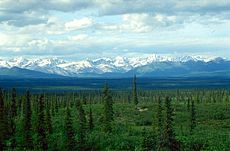 White spruce taiga along the Denali Highway in the Alaska Range
White spruce taiga along the Denali Highway in the Alaska Range
White spruce is the northernmost tree species in North America, reaching just north of 69°N latitude in the Mackenzie River delta.[7] It grows between sea level and an elevation of 1,520 metres (4,990 ft). Its northern distribution roughly correlates to the location of the tree line, which includes an isothermic value of 10 °C (50 °F) for mean temperature in July, as well as the position of the Arctic front; cumulative summer degree days, mean net radiation, and the amount of light intensities also figure. White spruce generally is found in regions where the growing season exceeds 60 days annually.[6]
The southern distribution corresponds to the July isotherm of 18 °C (64 °F) around the Great Lakes; in the Prairie Provinces its limit is north of this isotherm. During the summer solstice, photoperiod values range from 17 hours at its southern limits to 24 hours above the Arctic Circle.[6]
Ecology
White spruce generally occurs on well-drained soils in alluvial and riparian zones, although it also occurs in soils of glacial and lacustrine origin.[6] The understory is dominated by feather mosses (Hylocomium splendens and Pleurozium schreberi, Ptilium cristacastrensis, and Dicranum spp.), and occasionally peat moss.[8] In the far north, the total depth of the moss and underlying humus is normally between 25 to 46 centimetres (9.8 to 18 in), although it tends to be shallower when hardwoods are present in the stand.[6]
White spruce grows in soils with pH values of 4.7—7.0, although they have been found in soils as acidic as 4.0 in subalpine fir forests in the Northwest Territories. A presence of calcium in the soil is common to white spruce found in New York. White spruce most commonly grows in the soil orders of Alfisols and Inceptisols. Soil properties such as fertility, temperature, and structural stability are partial determinants of the ability of white spruce to grow in the extreme northern latitudes.[6] In the northern limits of its range, white spruce is the climax species along with black spruce; Birch and aspen are the early succession species.[8] Wildfires typically occur every 60 to 200 years, although they have been known to occur as infrequently as every 300 years.[8]
Varieties
Several geographical varieties have been described, but are not accepted as distinct by all authors. These comprise, from east to west:[1][2]
- Picea glauca var. glauca (Typical or Eastern white spruce). From Newfoundland west to eastern Alberta, on lowland plains.
- Picea glauca var. densata (Black Hills white spruce). The Black Hills in South Dakota.
- Picea glauca var. albertiana (Alberta white spruce). The Rocky Mountains in Alberta, British Columbia and northwest Montana.
- Picea glauca var. porsildii (Alaska white spruce). Alaska and Yukon.
The two western varieties are distinguished by pubescent (downy) shoots, and may be related to extensive hybridisation and/or intergradation with the closely related Engelmann Spruce found further south in the Rocky Mountains. White spruce also hybridises readily with the closely related Sitka Spruce where they meet in southern Alaska; this hybrid is known as Picea × lutzii.[1][2]
Predators
Outbreaks of spruce beetles have destroyed over 2,300,000 acres (9,300 km2) of forests in Alaska.[9]
Uses
Black Hills spruce grown as bonsaiA dwarf cultivar of the Alberta white spruce, Picea glauca var. albertiana 'Conica', is a popular garden plant. It has very slender leaves, like those normally found only on one-year-old seedlings, and very slow growth, typically only 2–10 centimetres (0.79–3.9 in) per year. Older specimens commonly 'revert', developing normal adult foliage and starting to grow much faster; this 'reverted' growth must be pruned if the plant is to be kept dwarf.
White spruce is of major economic importance in Canada for its wood, harvested for paper-making. It is also used to a small extent as a Christmas tree.
The wood is also exported to Japan where, known as "shin-kaya", it is used to make go boards as a substitute for the rare kaya wood.
White spruce is the provincial tree of Manitoba and the state tree of South Dakota.
See also
References
- ^ a b c d e Farjon, A. (1990). Pinaceae. Drawings and Descriptions of the Genera. Koeltz Scientific Books ISBN 3-87429-298-3.
- ^ a b c d e Rushforth, K. (1987). Conifers. Helm ISBN 0-7470-2801-X.
- ^ Conifer Specialist Group (1998). Picea glauca. 2006. IUCN Red List of Threatened Species. IUCN 2006. www.iucnredlist.org. Retrieved on 12 May 2006.
- ^ Gymnosperm Database: Picea glauca
- ^ Flora of North America: Picea glauca
- ^ a b c d e f Nienstaedt, Hans; Hans Nienstaedt and John C. Zasada (1990). "Picea glauca (Moench) Voss" (html). Silvics of North America, Volume 1:Conifers. United States Forest Service. http://www.na.fs.fed.us/spfo/pubs/silvics_manual/Volume_1/picea/glauca.htm. Retrieved 2010-11-14.
- ^ Arno, S. F. & Hammerly, R. P. (1984). Timberline. Mountain and Arctic Forest Frontiers. The Mountaineers, Seattle. ISBN 0-89886-085-7.
- ^ a b c Trainor, Sarah (2010-11-02). "Meeting Alaska’s Fire Science and Climate Information Needs for Forest Managers". Forest Wisdom (Santa Fe, NM: Forestry Guild) (16): 4–5. http://www.forestguild.org/publications/forest_wisdom/Wisdom16.pdf. Retrieved 2010-11-11.
- ^ http://www.na.fs.fed.us/spfo/pubs/fidls/sprucebeetle/sprucebeetle.htm
Categories:- IUCN Red List least concern species
- Picea
- Taiga and boreal forests
- Trees of humid continental climate
- Trees of continental subarctic climate
- Least concern plants
- Ornamental trees
- Provincial symbols of Manitoba
- Trees of Alberta
- Trees of British Columbia
- Trees of Manitoba
- Trees of Ontario
- Trees of Saskatchewan
- Trees of Western Canada
- Trees of Alaska
- Trees of Maine
- Trees of Michigan
- Trees of Minnesota
- Trees of Montana
- Trees of New Hampshire
- Trees of New York
- Trees of Vermont
- Trees of Wisconsin
Wikimedia Foundation. 2010.


